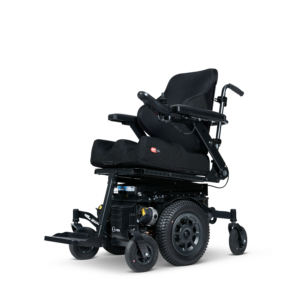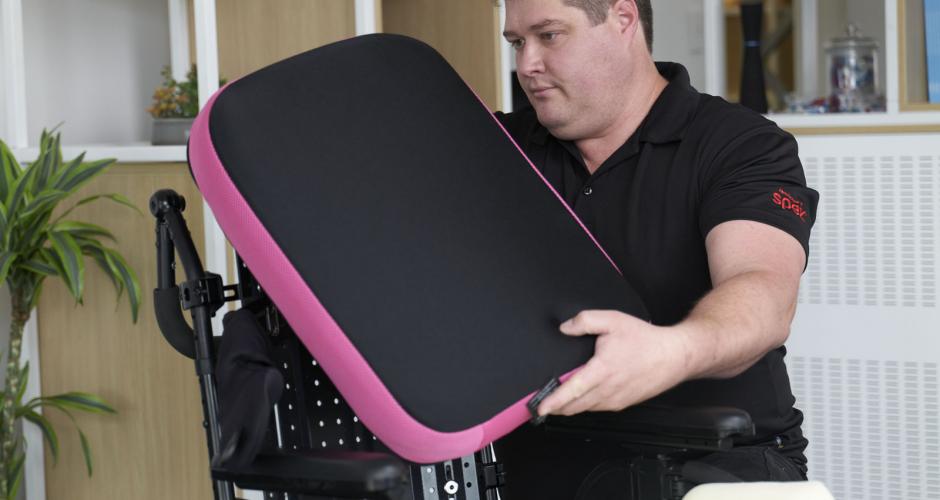In Part 1 of this blog series, we explored the definition of comfort, which clearly includes both physical and emotional aspects, and how we need to consider this within wheeled seated mobility. We explored how we do that, from a clinical perspective, in Part 2. Part 3 considered the delivery of comfort as it pertains to the emotional aspects of knowing that ongoing needs of a wheelchair user will be met by the service delivery and clinical knowledge available. Here, in Part 4, we will explore the link between ‘doing’ and comfort, through sharing the experiences of a wheelchair user, Rocket (name changed) and his Physiotherapist, Penny, both of whom I recently had an opportunity to interview.
“Wheeled mobility and assistive technology (AT) are an “ongoing process, as their [users’] impairments, their lifestyles, and their occupational roles changed over time.” (Layton, 2012)
We’ve discussed the physical and emotional components of comfort in previous blogs so let’s consider this within the context of meaningful occupations, or the ‘doing.’ For an Occupational Therapist ‘meaningful occupations’ consist of all the things you must do, need to do, or want to do. This ‘doing’ allows us to fulfil our life roles (such as: daughter, sister, caregiver, nurse, homemaker, mother, friend, part-time student), express ourselves (such as: gardener, DIY enthusiast, baker) and connect with others (such as: dinner host, scuba-diver, member of local walking club).
Having a wheelchair may mean that some roles and occupations need to change or be modified due to physical or environmental constraints. This will immediately affect emotional comfort because this may signify a loss, yet the wheelchair itself may be physically comfortable.
Being able to participate meaningfully in our occupations may mean we have greater emotional comfort and therefore may not pay attention to physical discomfort. I have the pleasure of working with Penny (Physiotherapist) and Rocket (wheelchair user with Spex) who said the following about comfort:
“Comfort and function are very much linked, because if you can go out and do what you want and be absorbed in what you want because your seating (or whatever) has given you the function to do that, you can tolerate far more and comfort sort of merges into the background and just becomes part of function. … you go to the cinema and they have the most uncomfortable seats known to man, but if you’re watching a really good film you don’t notice it. If the film’s tedious you really wriggle about on those seats because the seats are awful. And that to me is what comfort’s about. Comfort and function. It’s about giving you something to go out and do something you want to do and enjoy the life you want to enjoy.” (Penny, Physiotherapist)
“In the past when I had really bad seating and my legs were really numb, I was able to go out for long periods. Because I was engaging and active and going out doing talks and events, and lots of different things, I was able to not ‘not be comfortable’, [I’d still] be in a lot of pain – my function was being met so my comfort level was raised a bit more. You cannot separate function and comfort; it is interlinked together.” (Rocket)
I am mindful that the COVID-19 restrictions have meant that many wheelchair users globally may now be restricted from those meaningful occupations. Physical discomfort may be more noticeable because the emotional comfort of a good quality of life has changed.
Rocket’s experience highlighted these challenges because, although he’d successfully trialled the Spex Flex cushion, he could not use this until the rest of the wheelchair configuration was adjusted – which was delayed. Following a number of visits, he was provided with a full Spex seating system, including the Spex Supershape back support and various lateral trunk and hip supports.
“… when you came for your first initial visit with Penny. It was fantastic. I was like, this is great… I wanted to keep it [Spex Flex cushion] but I couldn’t keep it before it was properly setup on my wheelchair. So, I had to actually take it off my current wheelbase until you got the right size width of the cushion and the right adaptations and things. I thought, “wow, this could be really good.” And then COVID happened, and things got delayed even longer and even longer. Because I’ve got congenital muscular dystrophy which is a muscle wasting condition – I also have severe scoliosis, which means … my spine is like wet spaghetti – I can’t really support myself. So, gravity is always putting a lot of pressure onto my sciatic nerve in my right hip and the scoliosis makes it much more challenging. So, having the Spex [Flex] cushion was like, wow, this could be really great. And luckily got the Wheelchair Services to push forward to get the Spex back as well – which I actually love, the Spex back. Its just like laying on a cloud …” (Rocket)
The first full session took around 4.5 hours with many individuals working on the different components whilst supporting his position in sitting and which, no doubt, was uncomfortable with hoist transfers, readjustments, and adaptation of the wheelchair configuration. Yet this was stated as a positive:
“Yes, yes, it is a step in the right direction. … I think how it has helped out it’s given me the ability to sit straighter. Definitely. And to sit more comfortably. And it’s given me more options…” (Rocket)
Any wheelchair and seating system should consider physical and emotional comfort including facilitating doing. Finding the right seating system is dependent on thorough clinical assessment, an understanding of the wheelchair user’s goals and occupations, and planning for future changes wherever possible. Key to ensuring we optimise comfort and doing, is effective communication.
“Something that I will never forget … about my posture and my seating. Penny said to me, “Just think about your shoes, right? You have indoor shoes; you have outdoor shoes.” And we’re asking a lot of our seating in a wheelchair to do what I really want to do in my life. …since I met Penny, I’ve become so much more aware of my posture and my seating – “Oh that’s want it means to not be able to function,” … having another opinion as well as having seating, was really good info. What has really transformed my life, that actually understanding my posture, understanding my body has really helped in that sense, and so, yeah. I’m so grateful to Penny in particular, that she stuck it out – I really appreciate Penny so much. Her creativity… her compassion is second to none.
I remember the first time I met Penny, the first thing she did – she asked me a set of questions: What are my goals? What would I like to do? Nobody had actually sat down, ever, to ask me who I was as a person. Not just, “Okay, you’re sitting in the wrong way, so we have to give you a moulded seating or a matrix system.” And so understanding who I was and who I wanted to be, that really helped me as well to, “Okay, what kind of seating is going to work and what isn’t going to work?” – to understanding, and then using this fact to know, “Actually, this is the limitation you have, this is the problems that you have,” to basically deal with it and how we want to adapt.” (Rocket)
In my opinion, comfort will forever remain a challenging concept to master considering the complexity of what makes us feel comfortable, and the impact that participation in meaningful occupations can have on reducing discomfort. Addressing comfort, however, can shape better lives allowing wheelchair users to express themselves, connect with others, do those activities that are meaningful and necessary for them without excessive pain or physical discomfort. The service provision, communication and shared-goal setting between wheelchair user and prescriber is as important. Similarly, the monitoring of posture and wheelchair maintenance is a necessity. In this way a wheelchair can shape better lives by making ‘doing’ possible.
A colleague recently said that comfort is a dirty word when prescribing wheelchairs, but I do not think it can be omitted completely from the clinical reasoning behind wheelchair provision specific for each user’s unique body shape, postural presentation, clinical needs and lifestyle. If a seating system is not comfortable, it won’t be used often and will likely restrict engagement in meaningful occupations. If a seating system is not functional, it won’t be used at all.
Thank you for reading!





